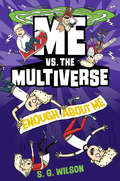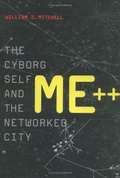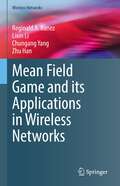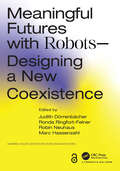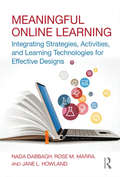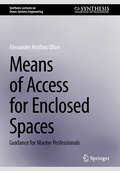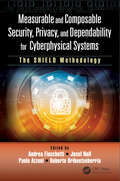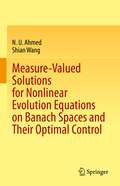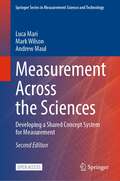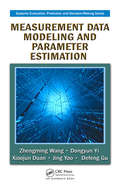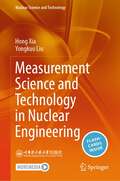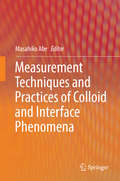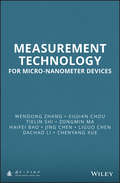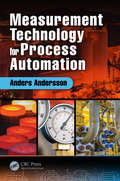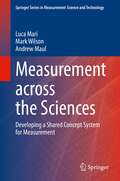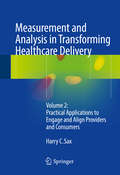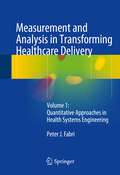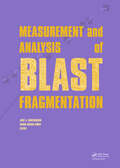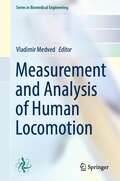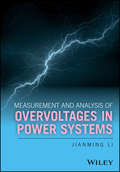- Table View
- List View
Me and My Place in Space (Me. . Books! Ser.)
by Joan SweeneyWhere am I in the solar system? A beloved bestseller, now refreshed with new art from Christine Gore, that will help children discover their place in the Milky Way. Where is the earth? Where is the sun? Where are the stars? Now with new art by Christine Gore, here is an out-of-this world introduction to the universe for children. With Earth as a starting point, a young astronaut leads readers on a tour past each planet and on to the stars, answering simple questions about our solar system. In clear language, drawings, and diagrams, space unfolds before a child's eyes. Colorful illustrations, filled with fun detail, give children a lot to look for on every page, and a glossary helps reinforce new words and concepts. A terrific teaching tool, Me and My Place in Space is an easy and enjoyable way to introduce the concept of space to budding astronomers.
Me and the Sky: Captain Beverley Bass, Pioneering Pilot
by Beverley Bass Cynthia WilliamsThe groundbreaking female pilot featured in the hit Broadway musical Come from Away tells her story in this high-flying and inspiring picture-book autobiography!When Beverley Bass was a young girl in the late 1950s, she told her parents she wanted to fly planes--and they told her that girls couldn't be pilots. Still, they encouraged her, and brought her to a nearby airport to watch the planes take off and land.After decades of refusing to take no for an answer, in 1986 Beverley became the first female pilot promoted to captain by American Airlines and led the first all-female crewed flight shortly thereafter. Her revolutionary career became even more newsworthy when she was forced to land in the remote town of Gander, Newfoundland, on September 11, 2001, due to US airspace closures. After several days there, she flew her crew and passengers safely home.Beverley's incredible life is now immortalized in the hit Broadway musical Come from Away. Here, discover how she went from an ambitious young girl gazing up at the sky to a groundbreaking pilot smiling down from the cockpit."Inspiring and up, up, and away all the way."--Kirkus"An inspiring biography about one woman's determination to forge a new path."--Booklist
Me vs. the Multiverse: Enough About Me (Me vs. the Multiverse #2)
by S. G. WilsonCan plain old Average Me fix the rip in the multiverse? The Mes are back in this hilarious second book in the sci-fi comedy series for fans of Stuart Gibb's Moon Base Alpha and quirky animated shows like Rick and Morty and Regular Show.Saving the multiverse starts with another origami note: Make it here, pronto.This time Meade Macon, aka Average Me, knows that parallel dimensions are real. He's met dozens of his counterparts from other Earths. What he doesn't know is that they're all about to get zapped out of existence.On Earth Zero, a rip in the multiverse is spreading to other realities and causing chaos wherever it appears. And the different versions of Meade--the Mes--are caught in the middle! Motor Me, Resist Me, and Hollywood Me just want to go back home to their own Earths. The only way to do that is to repair the rip. Once again, it's up to Average Me! But if Average is going to fix the multiverse, he just might have to team up with his archnemesis . . . Meticulous Me.
Me++: The Cyborg Self and the Networked City
by William J. MitchellWilliam Mitchell describes the transformation of wireless technology in the hundred years since Marconi; the scaling up of networks and the scaling down of the apparatus for transmission and reception.
Mean Field Game and its Applications in Wireless Networks (Wireless Networks)
by Zhu Han Reginald A. Banez Lixin Li Chungang YangThis book covers the basic theory of mean field game (MFG) and its applications in wireless networks. It starts with an overview of the current and future state-of-the-art in 5G and 6G wireless networks. Then, a tutorial is presented for MFG, mean-field-type game (MFTG), and prerequisite fields of study such as optimal control theory and differential games. This book also includes a literature survey of MFG-based research in wireless network technologies such as ultra-dense networks (UDNs), device-to-device (D2D) communications, internet-of-things (IoT), unmanned aerial vehicles (UAVs), and mobile edge networks (MENs). Several applications of MFG and MFTG in UDNs, social networks, and multi-access edge computing networks (MECNs) are introduced as well.Applications of MFG covered in this book are divided in three parts. The first part covers three single-population MFG research works or case studies in UDNs including ultra-dense D2D networks, ultra-dense UAV networks, and dense-user MECNs. The second part centers on a multiple-population MFG (MPMFG) modeling of belief and opinion evolution in social networks. It focuses on a recently developed MPMFG framework and its application in analyzing the behavior of users in a multiple-population social network. Finally, the last part concentrates on an MFTG approach to computation offloading in MECN. The computation offloading algorithms are designed for energy- and time-efficient offloading of computation-intensive tasks in an MECN. This book targets advanced-level students, professors, researchers, scientists, and engineers in the fields of communications and networks. Industry managers and government employees working in these same fields will also find this book useful.
Mean and Lowly Things: Snakes, Science, and Survival in the Congo
by Kate JacksonIn 2005 Kate Jackson ventured into the remote swamp forests of the northern Congo to collect reptiles and amphibians. Her camping equipment was rudimentary, her knowledge of Congolese customs even more so. She knew how to string a net and set a pitfall trap, but she never imagined the physical and cultural difficulties that awaited her. Culled from the mud-spattered pages of her journals, Mean and Lowly Things reads like a fast-paced adventure story. It is Jackson’s unvarnished account of her research on the front lines of the global biodiversity crisis—coping with interminable delays in obtaining permits, learning to outrun advancing army ants, subsisting on a diet of Spam and manioc, and ultimately falling in love with the strangely beautiful flooded forest. The reptile fauna of the Republic of Congo was all but undescribed, and Jackson’s mission was to carry out the most basic study of the amphibians and reptiles of the swamp forest: to create a simple list of the species that exist there—a crucial first step toward efforts to protect them. When the snakes evaded her carefully set traps, Jackson enlisted people from the villages to bring her specimens. She trained her guide to tag frogs and skinks and to fix them in formalin. As her expensive camera rusted and her Western soap melted, Jackson learned what it took to swim with the snakes—and that there’s a right way and a wrong way to get a baby cobra out of a bottle.
Mean-Field-Type Games for Engineers
by Julian Barreiro-Gomez Hamidou TembineThe contents of this book comprise an appropriate background to start working and doing research on mean-field-type control and game theory. To make the exposition and explanation even easier, we first study the deterministic optimal control and differential linear-quadratic games. Then, we progressively add complexity step-by-step and little-by-little to the problem settings until we finally study and analyze mean-field-type control and game problems incorporating several stochastic processes, e.g., Brownian motions, Poisson jumps, and random coefficients. We go beyond the Nash equilibrium, which provides a solution for non- cooperative games, by analyzing other game-theoretical concepts such as the Berge, Stackelberg, adversarial/robust, and co-opetitive equilibria. For the mean-field-type game analysis, we provide several numerical examples using a Matlab-based user-friendly toolbox that is available for the free use to the readers of this book. We present several engineering applications in both continuous and discrete time. Among these applications we find the following: water distribution systems, micro-grid energy storage, stirred tank reactor, mechanism design for evolutionary dynamics, multi-level building evacuation problem, and the COVID-19 propagation control. Julian Barreiro-Gomez Hamidou Tembine With such a demand from engineering audiences, this book is very timely and provides a thorough study of mean-field-type game theory. The strenuous protagonist of this book is to bridge between the theoretical findings and engineering solutions. The book introduces the basics first, and then mathematical frameworks are elaborately explained. The engineering application examples are shown in detail, and the popular learning approaches are also investigated. Those advantageous characteristics will make this book a comprehensive handbook of many engineering fields for many years, and I will buy one when it gets published. Zhu Han
Meaningful Futures with Robots: Designing a New Coexistence (Chapman & Hall/CRC Artificial Intelligence and Robotics Series)
by Marc Hassenzahl Judith Dörrenbächer Ronda Ringfort-Felner Robin NeuhausSoon, robots will leave the factories and make their way into living rooms, supermarkets, and care facilities. They will cooperate with humans in everyday life, taking on more than just practical tasks. How should they communicate with us? Do they need eyes, a screen, or arms? Should they resemble humans? Or may they enrich social situations precisely because they act so differently from humans? Meaningful Futures with Robots: Designing a New Coexistence provides insight into the opportunities and risks that arise from living with robots in the future, anchored in current research projects on everyday robotics. As well as generating ideas for robot developers and designers, it also critically discusses existing theories and methods for social robotics from different perspectives - ethical, design, artistical and technological – and presents new approaches to meaningful human-robot interaction design. Key Features: Provides insights into current research on robots from different disciplinary angles with a particular focus on a value-driven design. Includes contributions from designers, psychologists, engineers, philosophers, artists, and legal scholars, among others.
Meaningful Online Learning: Integrating Strategies, Activities, and Learning Technologies for Effective Designs
by Nada Dabbagh Jane L. Howland Rose M. MarraMeaningful Online Learning explores the design and facilitation of high-quality online learning experiences and outcomes through the integration of theory-based instructional strategies, learning activities, and proven educational technologies. Building on the authors’ years of synthesized research and expertise, this textbook prepares instructors in training to create, deliver, and evaluate learner-centered online pedagogies. Pre- and in-service K–12 teachers, higher education faculty, and instructional designers in private, corporate, or government settings will find a comprehensive approach and support system for their design efforts.
Meaningful Stuff: Design That Lasts (Design Thinking, Design Theory)
by Jonathan ChapmanAn argument for a design philosophy of better, not more.Never have we wanted, owned, and wasted so much stuff. Our consumptive path through modern life leaves a wake of social and ecological destruction--sneakers worn only once, bicycles barely even ridden, and forgotten smartphones languishing in drawers. By what perverse alchemy do our newest, coolest things so readily transform into meaningless junk? In Meaningful Stuff, Jonathan Chapman investigates why we throw away things that still work, and shows how we can design products, services, and systems that last. Obsolescence is an economically driven design decision--a plan to hasten a product's functional or psychological undesirability. Many electronic devices, for example, are intentionally impossible to dismantle for repair or recycling, their brief use-career proceeding inexorably to a landfill. A sustainable design specialist who serves as a consultant to global businesses and governmental organizations, Chapman calls for the decoupling of economic activity from mindless material consumption and shows how to do it.Chapman shares his vision for an "experience heavy, material light" design sensibility. This vital and timely new design philosophy reveals how meaning emerges from designed encounters between people and things, explores ways to increase the quality and longevity of our relationships with objects and the systems behind them, and ultimately demonstrates why design can--and must--lead the transition to a sustainable future.
Means of Access for Enclosed Spaces: Guidance for Marine Professionals (Synthesis Lectures on Ocean Systems Engineering)
by Alexander Arnfinn OlsenThis book provides critical information relating to the design and construction of means of access onboard marine vessels and platforms, including ladders, walkways and ramps, hatches, and alternative access points. Uniquely, this book highlights the importance of considering human factors and ergonomics in engineering design. In support of the Statutory and IACS guidance, this book has been written to provide graphical illustrations and additional textual clarification of the means of access requirements. The goal is to improve the comprehension and application of the Statutory and IACS guidance. Conceptually, this text presents two levels of means of access guidance. The first provides the base criteria to meet the IMO requirements. The second, and preferred, level of guidance incorporates the application of current ergonomics practices to the means of access requirements. The application of ergonomics to the means of access requirements will enhance levels of safety as well as quality of work by providing appropriate access for survey, inspection and maintenance activities for tanks and holds.
Measurable and Composable Security, Privacy, and Dependability for Cyberphysical Systems: The SHIELD Methodology
by Andrea Fiaschetti Josef Noll Paolo Azzoni Roberto UribeetxeberriaWith a business baseline focused on the impact of embedded systems in the years ahead, the book investigates the Security, Privacy and Dependability (SPD) requirements raised from existing and future IoT, Cyber-Physical and M2M systems. It proposes a new approach to embedded systems SPD, the SHIELD philosophy, that relies on an overlay approach to SPD, on a methodology for composable SPD, on the use of semantics, and on the design of embedded systems with built-in SPD. The book explores new ground and illustrates the development of approximately forty prototypes capable of managing and enhancing SPD, including secure boot, trusted execution environments, adaptable radio interfaces, and different implementations of the middleware for measuring and composing SPD.
Measure-Valued Solutions for Nonlinear Evolution Equations on Banach Spaces and Their Optimal Control
by N. U. Ahmed Shian WangThis book offers the first comprehensive presentation of measure-valued solutions for nonlinear deterministic and stochastic evolution equations on infinite dimensional Banach spaces. Unlike traditional solutions, measure-valued solutions allow for a much broader class of abstract evolution equations to be addressed, providing a broader approach.The book presents extensive results on the existence of measure-valued solutions for differential equations that have no solutions in the usual sense. It covers a range of topics, including evolution equations with continuous/discontinuous vector fields, neutral evolution equations subject to vector measures as impulsive forces, stochastic evolution equations, and optimal control of evolution equations. The optimal control problems considered cover the existence of solutions, necessary conditions of optimality, and more, significantly complementing the existing literature.This book will be of great interest to researchers in functional analysis, partial differential equations, dynamic systems and their optimal control, and their applications, advancing previous research and providing a foundation for further exploration of the field.
Measurement Across the Sciences: Developing a Shared Concept System for Measurement (Springer Series in Measurement Science and Technology)
by Mark Wilson Luca Mari Andrew MaulThis open access book proposes a conceptual framework for understanding measurement across a broad range of scientific fields and areas of application, such as physics, engineering, education, and psychology. It addresses contemporary issues and controversies within measurement in light of the framework, including operationalism, definitional uncertainty, and the relations between measurement and computation, and describes how the framework, operating as a shared concept system, supports understanding measurement’s work in different domains, using examples in the physical and human sciences.This revised and expanded second edition features a new analysis of the analogies and the differences between the error/uncertainty-related approach adopted in physical measurement and the validity-related approach adopted in psychosocial measurement. In addition, it provides a better analysis and presentation of measurement scales, in particular about their relations with quantity units, and introduces the measurand identification/definition as a part of the "Hexagon Framework" along with new examples from the physical and psychosocial sciences. Researchers and academics across a wide range of disciplines including biological, physical, social, and behavioral scientists, as well as specialists in measurement and philosophy appreciate the work’s fresh and provocative approach to the field at a time when sound measurements of complex scientific systems are increasingly essential to solving critical global problems.
Measurement Data Modeling and Parameter Estimation (Systems Evaluation, Prediction, and Decision-Making)
by Xiaojun Duan Zhengming Wang Dongyun Yi Jing Yao Defeng GuThis book discusses the theories, methods, and application techniques of the measurement data mathematical modeling and parameter estimation. It seeks to build a bridge between mathematical theory and engineering practice in the measurement data processing field so theoretical researchers and technical engineers can communicate. It is organized with abundant materials, such as illustrations, tables, examples, and exercises. The authors create examples to apply mathematical theory innovatively to measurement and control engineering. Not only does this reference provide theoretical knowledge, it provides information on first hand experiences.
Measurement Science and Technology in Nuclear Engineering (Nuclear Science and Technology)
by Hong Xia Yongkuo LiuThis book highlights the fundamentals and advances in measurement science and technology applied in nuclear power engineering. Inspection of main parameters is an essential part of the operation and control of nuclear power plants. Measurement science and technology in nuclear engineering have experienced fast upgrades with the rapid advancements in computer science, sensors, lasers, and other related technologies. The book not only describes basic theories and widely used techniques but also presents novel experimental findings, newly applied techniques, and future trends that emerge with the higher and more specialized requirements of today’s nuclear power plants and other nuclear projects. The book serves as a valuable information source for scientists and a good handbook for engineers. It also contains well-arranged questions and exercises after each chapter, which makes it an excellent textbook for undergraduate and graduate students in nuclear science and technology.Additional questions and answers via app: Download the Springer Nature Flashcards app free of charge and use exclusive additional material to test your knowledge.
Measurement Techniques and Practices of Colloid and Interface Phenomena
by Masahiko AbeThis book is a manual of measurement of colloids and interfaces designed especially for new researchers who have just begun research on these topics. The book is written by active researchers in the field of colloids and interfacial chemistry, based on the practical experience of the authors. In each chapter, the key points of measurement, how to analyze data correctly, points to be careful about, and merits of a particular method are concisely explained from the point of view of the readers. Not only in industries such as cosmetics and pharmaceuticals but also in academic studies of nanotechnology, correct understanding of colloid and interface phenomena is vital because the properties of these items, however small, are affected by the nature of interfaces. This book will be particularly useful for researchers who are not yet fully confident of the measurement techniques that are clearly explained here.
Measurement Technology for Micro-Nanometer Devices
by Jingdong Chen Zongmin Ma Wendong Zhang Xiujian Chou Tielin Shi Haifei Bao Liguo Chen Dachao Li Chenyang XueA fully comprehensive examination of state-of-the-art technologies for measurement at the small scale• Highlights the advanced research work from industry and academia in micro-nano devices test technology• Written at both introductory and advanced levels, provides the fundamentals and theories• Focuses on the measurement techniques for characterizing MEMS/NEMS devices
Measurement Technology for Process Automation
by Anders AnderssonAlmost every industry that use liquids and gas in any form has a need to measure flow, temperature and pressure. This text is a practical guide on how to accurately use these measuring instruments to control processes in manufacturing industries for food, beverages, chemicals, pharmaceuticals, oil, water and waste water, power, etc. With higher prices of raw materials and more severe requirements for safety and environmental issues, there is a growing demand to measure with higher precision. The book includes a number of practical examples from various industries. It discusses how to comply with safety standards regarding measurements and explains how legal control systems apply to measurements. The aim is to help any process industry reduce the risk of high costs and damage to both people and equipment.
Measurement across the Sciences: Developing a Shared Concept System for Measurement (Springer Series in Measurement Science and Technology)
by Mark Wilson Luca Mari Andrew MaulThis book proposes a conceptual framework for understanding measurement across a broad range of scientific fields and areas of application, such as physics, engineering, education, and psychology. The authors, who themselves span these disciplines, argue that the justification of the public trust attributed to measurement results can in principle apply identically to both physical and psychosocial properties. They further argue that the lack of a common conceptualization of measurement hampers interdisciplinary communication and limits the ability to share knowledge. They advance their views by first surveying the conceptual history of the philosophy of measurement and arguing that classical, operationalist and representational perspectives on measurement each make important contributions but also each have important shortcomings. A synthesis is then offered as the foundation for a new conceptual framework. The authors describe how the framework, which operates as a shared concept system, supports understanding measurement’s work in different domains, using examples in the physical and human sciences. They consider connections and consequences with respect to causality, objectivity, and intersubjectivity, among other topics, and how measurement science concepts and issues are construed across these disciplines and settings. They also address contemporary issues and controversies within measurement in the light of the framework, including operationalism, definitional uncertainty, and the relations between measurement and computation. The book concludes with a justification for the basic claim that measurement is an empirical and informational process that produces explicitly justifiable information. Researchers and academics across a wide range of disciplines including biological, physical, social and behavioral scientists, as well as specialists in measurement and philosophy will appreciate the work’s fresh and provocative approach to the field at a time when sound measurements of complex scientific systems are increasingly essential to solving critical global problems.
Measurement and Analysis in Transforming Healthcare Delivery
by Harry C. SaxThis volume is complementary to Volume 1: Quantitative Approaches in Health Systems Engineering which provides in-depth analysis of the statistical and quantitative aspects of Health Systems Engineering. Volume 2: Practical Applications to Engage and Align Providers and Consumers builds upon these concepts with the integration of additional economic, performance and quality measures. Stressing the importance of changes in the economics of health care financing, it will serve as a resource for not only leaders of organizations, but also providers who will be practicing a different type of medicine from that of which they were trained. After defining the challenges, the authors will quantify and define funds flows and various margins necessary for viability, how providers will be measured and rewarded for quality, and the importance of accurate dashboard of physician performance. Types of payment systems, including capitation, ACOs, risk contracts, and hybrid forms of fee for service will be defined and their relative advantages discussed. Lessons from other countries that provide high quality care at a lower cost will be examined for applicability to our challenges. Finally, experts in leadership will focus on influencing behavior to achieve results while remembering that healthcare is about the patient. This textbook will serve as a useful resource for clinicians, healthcare executives, governmental agencies, and emerging leaders in organizations.
Measurement and Analysis in Transforming Healthcare Delivery
by Peter J. FabriThis volume provides the important concepts necessary for a physician to participate in a reengineering process, develop decision-making skills based on probability and logic rather than "rules," and to measure and analyze meaningful outcomes of care delivery. This approach has been developed over ten years in a medical student-based program and has been enthusiastically embraced by medical students without backgrounds in engineering or statistics. More specifically, this text will introduce physicians to relevant and available computer software, combined with an in depth knowledge of measurement, variation, and uncertainty. It provides a basis for the transformation of data into information, information into knowledge, and knowledge into wisdom. The first quarter of the book will address understanding and visualizing data, using statistical and graphic analysis. The next quarter addresses the fundamentals of applied statistics, and the application of conditional probability to clinical decision making. The next quarter addresses the four "cornerstones" of modern analytics: regression, classification, association analysis, and clustering. The final section addresses the identification of outliers and their importance in understanding, the assessment of cause and effect and the limitations associated with retrospective data analysis. This toolbox will prepare the interested physician to actively engage in the identification of problem areas, the design of process-based solutions, and the continuous assessment of outcomes of clinical practice. Armed with this toolbox, the reader will be "prepared to make a difference" in the rapidly changing world of healthcare delivery. Measurement and Analysis in Transforming Healthcare Delivery is an excellent resource for general practitioners, health administrators, and all medical professionals interacting with healthcare delivery.
Measurement and Analysis of Blast Fragmentation
by José A. Sanchidrián Ashok Kumar SinghFragmentation characteristics influence mucking productivity, crusher throughput and energy consumption, plant efficiency, yield and recovery, or the price itself of the end product in the case of industrial minerals and aggregates. Reliable, quantitative measurements of fragment sizes are instrumental in controlling and optimizing the blasting res
Measurement and Analysis of Human Locomotion (Series in Biomedical Engineering)
by Vladimir MedvedThis book addresses instruments, methodologies and diagnostic methods used to evaluate and diagnose human movement, locomotion and physical status in general. Starting from historical perspective, the idea of understanding human locomotion by applying technical measurement devices and incorporating measurement data into physical representation of gross body movement is presented and explained, an approach known as inverse dynamics. With this approach as a kind of umbrella concept, components of measurement systems including relevant signal and data processing methods are described. Modern instruments to capture body movement by measuring its kinematics, kinetics and surface electromyography (sEMG) are thus described; all systems being used dominantly—if not exclusively—in a movement analysis laboratory setting. Focusing mainly on human posture and gait, but including also examples of movement patterns from selected kinesiological and sports activities, the book attempts to present essentials of biomechanics and biomedical engineering approach to this subject matter. It illustrates how data collected and elaborated by modern engineering technology can complement traditional expert knowledge of a kinesiologist or a medical doctor. The book is applicable in the fields of sports, physical activities, as well as in medical diagnostics and rehabilitation. The examples of this book’s practical application might be in evaluation of efficiency of human gait, in evaluation of skeletal muscle fatigue in physical exercise, in biomechanical diagnostics of traumatological conditions requiring orthopaedic treatment and the like. This book can also be used in planning and executing research endeavours, particularly in a clinical context as a reference for various diagnostics procedures. It presents the lecture notes of a course carrying the same name within Medical Studies in English at the University of Zagreb for more than a decade.
Measurement and Analysis of Overvoltages in Power Systems
by Jianming LiMeasurement and Analysis of Overvoltages in Power Systems Jianming Li, Professor, State Grid Corporation, China A combination of theory and application, this book features practical tests and analytical techniques comprehensively with engineering practicality as its focus. Based on years of research and industry experience, the author introduces many scientific research methods such as overvoltage simulation studies, dynamic simulation experiment platform development and application, and overvoltage pattern recognition. Readers will get a good grounding in the various sources of overvoltages in power systems, methods in on-line measurements as well as explanations of overvoltage formation mechanisms and monitoring analysis methods. •Systematically examines sources, online measurements, analytical techniques, and simulations of overvoltages, with an emphasis on engineering practicality •Presents practical engineering examples analyzing overvoltages and improving system operation, based on field experiments and data analysis •Features overvoltage simulations and waveform analysis in transmission systems Measurement and Analysis of Overvoltages in Power Systems is intended as an all-in-one guide for engineers and researchers in power systems engineering. It can be used as a reference text for graduate students and lecturers of electrical engineering.


